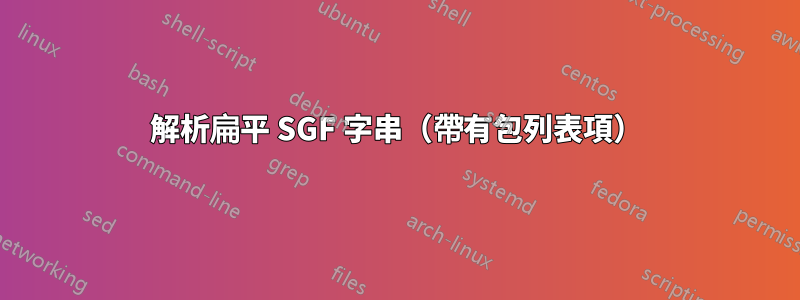
我正在嘗試解析肝細胞生長因子與包一起的字串listofitems。 SGF 是文字形式的樹,但為了簡單起見,現在我只研究單一分支的 SGF。
這是我正在嘗試做的事情的一個例子:
\documentclass{article}
\usepackage{listofitems}
\usepackage{tikz}
\newcommand{\parseSgf}[1]{
% From [this answer by @StevenB.Segletes](https://tex.stackexchange.com/a/429895/64441).
\setsepchar{;}
\defpair{[]}
\readlist\Z{#1}
\begin{itemize}
\foreach \i in {\Z}{
% TODO: if key is either `B` or `W`:
\item Color: {\i}[0] and Coords: {\i}[1]
}
\end{itemize}
}
\begin{document}
\def\sgfA{;B[ab];W[cd]}
\def\sgfB{(;GM[1]FF[4]CA[UTF-8]AP[Sabaki:0.52.2]KM[6.5]SZ[19]DT[2024-02-05];B[as];W[bs];B[cs])}
\parseSgf{\sgfA}
\parseSgf{\sgfB}
\end{document}
sgfA不是正確的 SGF,只是一個簡單的例子。我希望它列印一個像這樣的無序列表:
- 顏色:
B和座標:ab - 顏色:
W和座標:cd
但我一直無法弄清楚如何正確使用\setsepchar和\defpair分離事物,或者如何在\foreach.
sgfB是一個合適的 SGF 字串。還有一個額外的問題是忽略不是B或 的鍵W。如果有人知道如何做到這一點listofitems,那將是一個優勢。
答案1
我知道您主要對字串中具有語法B[xy]或的部分感興趣W[xy](其中x和y是一些單個字母)。因此,下面的程式碼忽略其他所有內容。
這可能不應該被視為最終版本,但也許類似的東西可以做到。在這種情況下,我使用了 expl 序列,因為大多數事情都與分割字串有關(請注意,如果字串不包含任何合適的語法,可能會彈出「缺少項目」錯誤):
\documentclass{article}
\ExplSyntaxOn
\cs_generate_variant:Nn \tl_set:Nn { Ne } % You might need to add this if the version of your TeX installation is not the most recent one
\cs_generate_variant:Nn \seq_set_split:Nnn { Nne }
\NewDocumentCommand{\parseSgf}{ m }{
\tl_set:Ne \l_tmpa_tl { #1 }
% remove ( and ) from string
\tl_remove_all:Nn \l_tmpa_tl { ( }
\tl_remove_all:Nn \l_tmpa_tl { ) }
% store the contents of #1 in a sequence with ; as delimiter
\seq_set_split:Nne \l_tmpa_seq { ; } { \l_tmpa_tl }
\begin{itemize}
% loop over all items in sequence
\seq_map_inline:Nn \l_tmpa_seq {
% split string at [ and store result in another sequence
\seq_set_split:Nne \l_tmpb_seq { [ } { ##1 }
\bool_if:nT {
% test if first part of sequence is B or W
\str_if_eq_p:ee { \seq_item:Nn \l_tmpb_seq { 1 } } { B } ||
\str_if_eq_p:ee { \seq_item:Nn \l_tmpb_seq { 1 } } { W }
} {
\tl_set:Ne \l_tmpa_tl { \seq_item:Nn \l_tmpb_seq { 1 } }
\tl_set:Ne \l_tmpb_tl { \seq_item:Nn \l_tmpb_seq { 2 } }
% remove ] from string
\tl_remove_all:Nn \l_tmpb_tl { ] }
\item Color: ~ \l_tmpa_tl {} ~ and ~ Coords: ~ \l_tmpb_tl
}
}
\end{itemize}
}
\ExplSyntaxOff
\begin{document}
\def\sgfA{;B[ab];W[cd]}
\def\sgfB{(;GM[1]FF[4]CA[UTF-8]AP[Sabaki:0.52.2]KM[6.5]SZ[19]DT[2024-02-05];B[as];W[bs];B[cs])}
\parseSgf{\sgfA}
\parseSgf{\sgfB}
\end{document}
答案2
這是一種listofitems方法。但是,它不會測試 SGF 字串中不正確的語法,例如;B[ab[;W]cd],它將以與測試案例相同的方式進行回應\sgfA。
\documentclass{article}
\usepackage{listofitems,tikz}
\long\def\Firstof#1#2\endFirstof{#1}
\ignoreemptyitems
\newcommand{\parseSgf}[1]{%
\setsepchar{;/[||]}%
\readlist*\Z{#1}%
\begin{itemize}
\foreachitem \i \in \Z[]{%
\itemtomacro\Z[\icnt,1]\tmp
% TODO: if key is either `B` or `W`:
\expandafter\if\expandafter\Firstof\tmp\endFirstof B
\item Color: \tmp and Coords: \Z[\icnt,2]
\else\expandafter\if\expandafter\Firstof\tmp\endFirstof W
\item Color: \tmp and Coords: \Z[\icnt,2]
\fi\fi
}%
\end{itemize}
}
\begin{document}
\def\sgfA{;B[ab];W[cd]}
\def\sgfB{(;GM[1]FF[4]CA[UTF-8]AP[Sabaki:0.52.2]KM[6.5]SZ[19]DT[2024-02-05];B[as];W[bs];B[cs])}
\parseSgf{\sgfA}\bigskip
\parseSgf{\sgfB}
\end{document}




